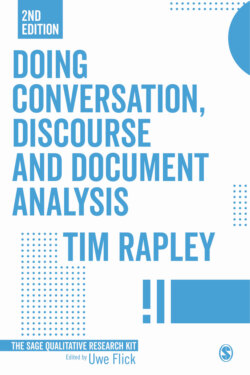Читать книгу Doing Conversation, Discourse and Document Analysis - Tim Rapley - Страница 24
На сайте Литреса книга снята с продажи.
Key points
ОглавлениеYou should generate an archive – a diverse collection of materials that enable you to engage with and think about the specific research problem or questions. Your archive could contain document-based sources as well as audio- and visual-based sources.
Read other academic work on your specific topic and find out what research materials they used and how they collected them.
Rather than solely relying on researcher-initiated audio- and visual-based materials – for example, interviews or focus groups – some academics argue that you should focus on ‘naturally occurring’ data.
Further reading
These sources explore in a little more detail the methods I addressed in this chapter:
Barbour, R. (2018) Doing Focus Groups (Book 4 of The SAGE Qualitative Research Kit, 2nd ed.). London: Sage.
Brinkmann, S. and Kvale, S. (2018) Doing Interviews (Book 2 of The SAGE Qualitative Research Kit, 2nd ed.). London: Sage.
Gidley, B. (2012) ‘Doing historical and archival research’, in C. Seale (ed.), Researching Society and Culture, 3rd ed. London: Sage, pp. 263–82.
Scott, J. (1990) A Matter of Record: Documentary Sources in Social Research. Cambridge: Polity Press.
Taylor, S. (2001) ‘Locating and conducting discourse analytic research’, in M. Wetherell, S. Taylor and S.J. Yates (eds), Discourse as Data: A Guide for Analysis. London: Sage, in association with The Open University, pp. 5–48.
